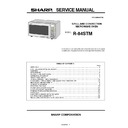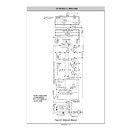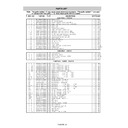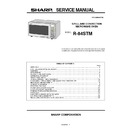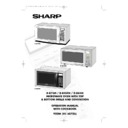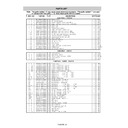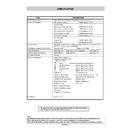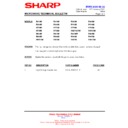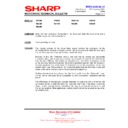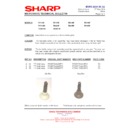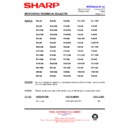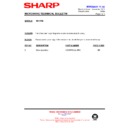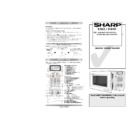Sharp R-84ST (serv.man3) Service Manual ▷ View online
R-84STM - 4
OVEN
APPEARANCE VIEW
1
2
3
4
5
8
7
6 10
9
10
12
11
1.
Grill heating element (top grill)
2.
Oven lamp
3.
Control panel
4.
Door opening button
5.
Waveguide cover
6.
Oven cavity
CONTROL PANEL
7.
Turntable motor shaft
8.
Grill heating element (bottom grill)
9.
Door seals
10.
Air-vent openings
11.
Outer cabinet
12.
Power cord
4
3
2
1
5
6
7
8
9
10
11
12
13
14
15
16
17
18
19
20
21
22
23
25
26
27
24
DIGITALAL DISPLAY
1.
1.
MICROWAVE indicator
2.
CONVECTION indicator
3.
BOTTOM GRILL indicator
4.
TOP GRILL indicator
5.
COOK indicator
6.
DEFROST indicator
7.
AUTO indicator
8.
LESS/MORE indicators
9.
INFO indicator
10.
MICROWAVE POWER LEVEL percentage
11.
WEIGHT indicators
CONTROL PANEL
12.
TIME keys
13.
INSTANT COOK keys
14.
EXPRESS COOK keys
15.
EXPRESS DEFROST keys
16.
MEAL IN ONE keys
17.
CONV. (
0
C) key
18.
DUAL CONV./GRILL key
19.
LESS/MORE keys
20.
INFO key
21.
START/AUTO MINUTE key
22.
STOP/CLEAR key
23.
KITCHEN TIMER/CLOCK SET key
24.
WEIGHT CONVERSION key
25.
WEIGHT keys
26.
MICRO. POWER key
27.
GRILL key
R-84STM - 5
ITEM
DESCRIPTION
Power Requirements
230 - 240 Volts / 50 Hertz / Single phase, 3 wire earthed
Power Consumption
Microwave cooking 1.45kW Approx. 6.5A
Dual cooking
(Microwave and Top Grill) 2.4kW Approx. 10.4A
(Microwave and Bottom grill) 1.95kW Approx. 8.5A
(Microwave and Convection) 2.4kW Approx. 10.4A
(Top and Bottom Grill) 1.55kW Approx. 6.3A
Convection cooking 2.08kW Approx. 9.1A
Grill Cooking
(Top Grill) 1.05kW Approx. 4.2A
(Bottom Grill) 0.55kW Approx. 2.3A
Power Output
900 watts nominal of RF microwave energy (measured by method of IEC
60705) Operating fequency 2450 MHz
60705) Operating fequency 2450 MHz
Grill heating element Power Output
Top Grill 1.kW
Bottom Grill 0.5kW
Case Dimensions
Width 520 mm
Height 309 mm (including foot)
Depth 488 mm
Cooking Cavity Dimensions
Width 349 mm
Height 207 mm
Depth 357 mm
Turntable diameter
325mm
Control Complement
Touch Control System
Microwave Cooking Control
Microwave Cooking Control
Repetition Rate;
HIGH ............. Full power throughout the cooking time
MEDIUM HIGH ............. approx. 70% of FULL Power
MEDIUM ....................... approx. 50% of FULL Power
MEDIUM LOW .............. approx. 30% of FULL Power
LOW ............................. approx. 10% of FULL Power
MEDIUM HIGH ............. approx. 70% of FULL Power
MEDIUM ....................... approx. 50% of FULL Power
MEDIUM LOW .............. approx. 30% of FULL Power
LOW ............................. approx. 10% of FULL Power
TIME keys STOP/CLEAR key
INSTANT COOK keys KITCHEN TIMER/CLOCK SET key
EXPRESS COOK keys WEIGHT CONVERSION key
EXPRESS DEFROST keys WEIGHT keys
MEAL IN
O
NE keys MICRO. POWER key
CONV. (
0
C) key GRILL key
DUAL CONV./GRILL key
LESS(
)/MORE(
) keys
INFO keys
START/AUTO MINUTE key
Net Weight
Approx. 20 kg
SPECIFICATION
As part of our policy of continuous improvement, we reserve the right to
alter design and specifications without notice
alter design and specifications without notice
Note:
Temperature measurements taken whilst the oven is in convection mode will differ from the displayed level.
This is due to the grill elements turning on and off in order to regulate the oven temperature.
This will not affect the cooking results as long as the operation manual and cook book are followed correctly.
Temperature measurements taken whilst the oven is in convection mode will differ from the displayed level.
This is due to the grill elements turning on and off in order to regulate the oven temperature.
This will not affect the cooking results as long as the operation manual and cook book are followed correctly.
R-84STM - 6
OFF CONDITION
Closing the oven door activates all door interlock switches
(monitored latch switch and stop switch).
(monitored latch switch and stop switch).
IMPORTANT:
When the oven door is closed, the contacts COM-NC of the
monitor switch SW2 must be open and the contacts (COM-
NO) must be closed. When the microwave oven is plugged
into a wall outlet (230-240V / 50Hz), 230-240 volts A.C. is
supplied to the point A1 + A3 in the control unit.
When the oven door is closed, the contacts COM-NC of the
monitor switch SW2 must be open and the contacts (COM-
NO) must be closed. When the microwave oven is plugged
into a wall outlet (230-240V / 50Hz), 230-240 volts A.C. is
supplied to the point A1 + A3 in the control unit.
1. The display starts demo mode.
2. To set any programmes or set the clock, you must first
2. To set any programmes or set the clock, you must first
touch the STOP key.
3. Information appears on display.
NOTE: When the oven door is opened, the oven lamp
NOTE: When the oven door is opened, the oven lamp
comes on at this time.
MICROWAVE COOKING CONDITION
HIGH COOKING
Enter a desired cooking time with the Time keys and start the
oven with touching START key.
Enter a desired cooking time with the Time keys and start the
oven with touching START key.
Function sequence Figure O-1 on page 18
CONNECTED COMPONENTS
RELAY
Oven lamp, Turntable motor
RY1
High voltage transformer
RY2
Fan motor
RY6
1 When the cooking time is up, a signal tone is heard and
the relays RY1 + RY2 + RY6 go back to their home
position. The circuits to the oven lamp, high voltage
transformer, fan motor and turntable motor are cut off.
position. The circuits to the oven lamp, high voltage
transformer, fan motor and turntable motor are cut off.
2. When the oven door is opened during a cooking cycle,
the switches come to the following condition.
Switch
Contact
Condition
During
During
Oven Door
Cooking
Open(No cooking)
Monitored latch Switch COM-NO
Closed
Opened
Monitor Switch
COM-NO
Closed
Opened
Monitor Switch
COM-NC
Opened
Closed
Stop switch
COM-NO
Closed
Opened
The circuit to the high voltage transformer, is cut off when the
contact of relay RY2 contacts COM-NO of the monitored
latch switch SW1, and monitor switch SW2 are made open.
The circuit to the fan motor is cut off when the relay RY6 is
made open. The circuit to the turntable motor is cut off when
the contacts COM-NO of the monitor switch are made open.
The relay RY2 and RY6 are made open when the door is
opened. The oven lamp remains on even if the oven door is
opened after the cooking cycle has been interrupted, because
the relay RY1 stays closed. Shown in the display is remaining
time.
3. MONITOR SWITCH CIRCUIT
contact of relay RY2 contacts COM-NO of the monitored
latch switch SW1, and monitor switch SW2 are made open.
The circuit to the fan motor is cut off when the relay RY6 is
made open. The circuit to the turntable motor is cut off when
the contacts COM-NO of the monitor switch are made open.
The relay RY2 and RY6 are made open when the door is
opened. The oven lamp remains on even if the oven door is
opened after the cooking cycle has been interrupted, because
the relay RY1 stays closed. Shown in the display is remaining
time.
3. MONITOR SWITCH CIRCUIT
The monitor switch SW2 is mechanically controlled by
the oven door, and monitors the operation of the monitored
latch switch SW1.
the oven door, and monitors the operation of the monitored
latch switch SW1.
3-1. When the oven door is opened during or after the cycle
of a cooking program, the monitored latch switch SW1
and stop switch SW3 must open their contacts (COM-
and stop switch SW3 must open their contacts (COM-
NO) first. After that the contacts (COM-NC) of the
monitor switch SW2 can be closed and the contacts
(COM-NO) of monitor switch SW2 are made open.
monitor switch SW2 can be closed and the contacts
(COM-NO) of monitor switch SW2 are made open.
3-2. When the oven door is closed. The contacts (COM-NC)
of the monitor switch SW2 must be opened and the
contacts (COM-NO) of monitor switch SW2 must be
closed. After that the contacts of the monitored latch
switch SW1 and the stop switch SW3 are made closed.
contacts (COM-NO) of monitor switch SW2 must be
closed. After that the contacts of the monitored latch
switch SW1 and the stop switch SW3 are made closed.
3-3. When the oven door is opened and the contacts of the
monitored latch switch SW1 remain closed, the fuse F2
F8A will blow. Because the relay RY1 and monitor
switch SW2 are closed and a short circuit is caused.
F8A will blow. Because the relay RY1 and monitor
switch SW2 are closed and a short circuit is caused.
3 seconds are needed for heating up the
magnetron filament.
magnetron filament.
32 sec. ON
24 sec. ON
18 sec. ON
12 sec. ON
6 sec. ON
8 sec. OFF
14 sec. OFF
20 sec. OFF
28 sec. OFF
HIGH
MEDIUM
HIGH
HIGH
MEDIUM
MEDIUM
LOW
LOW
LOW
Approx. 70%
Approx. 50%
Approx. 30%
Approx. 10%
Approx. 100%
MEDIUM HIGH, MEDIUM, MEDIUM LOW, LOW
COOKING
COOKING
When the microwave oven is preset for variable cooking
power, the 230-240 volts A.C. power is supplied to the high
voltage transformer intermittently within a 32-second time
base through the relay contact which is coupled with the
current-limiting relay RY2. The following levels of microwave
power are given.
power, the 230-240 volts A.C. power is supplied to the high
voltage transformer intermittently within a 32-second time
base through the relay contact which is coupled with the
current-limiting relay RY2. The following levels of microwave
power are given.
Note: The On/Off time ratio does not exactly correspond to
the percentage of microwave power, because approx.
Approx 100%
OPERATION SEQUENCE
R-84STM - 7
TEST PROCEDURES
SENSING FIRE OPERATION
The oven will stop its operation when there is a fire in the
oven cavity in microwave cooking condition.
LSI measures the voltage across the temperature measure-
ment circuit intermittently within a 32-second time base once
the oven is started in the microwave cooking mode. The oven
will stop its operation when the difference of the voltages is
more than 0.69 volts in microwave cooking condition.
oven cavity in microwave cooking condition.
LSI measures the voltage across the temperature measure-
ment circuit intermittently within a 32-second time base once
the oven is started in the microwave cooking mode. The oven
will stop its operation when the difference of the voltages is
more than 0.69 volts in microwave cooking condition.
1. Within a 32-second base, first the thermistor is energized
for 3 seconds. After 2 seconds since the thermistor is
energized, the voltage across the temperature
measurement circuit is measured. And after 21 seconds
since the thermistor is cut off, the convection motor
operates for 10 seconds.
energized, the voltage across the temperature
measurement circuit is measured. And after 21 seconds
since the thermistor is cut off, the convection motor
operates for 10 seconds.
2. The oven carries out the procedure above again. If the
second voltage is 0.69V higher than the first voltage, LSI
judges it is a fire in the oven cavity and stops the oven.
judges it is a fire in the oven cavity and stops the oven.
3. When sensor cooking, the sensing fire operation is not
carried out until the oven senses the steam from food.
Because food cannot be cooked well by rotating the
convection fan at that time. After sensing the steam, the
sensing fire operation is started.
Because food cannot be cooked well by rotating the
convection fan at that time. After sensing the steam, the
sensing fire operation is started.
CONVECTION
MOTOR
THERMISTOR
Sensing
Voltage
ON
OFF
ON
OFF
ON
OFF
0 2
20
30 32
64 (sec.)
3 sec.
Sensing the voltage across temperature measurement circuit.
4. When LSI judges it is fire in the oven cavity, LSI will switch
off the relays to the power transformer, fan motor and
convection motor and LSI stops counting down. And then
the damper is closed so that the fresh air does not come
into the oven cavity.
convection motor and LSI stops counting down. And then
the damper is closed so that the fresh air does not come
into the oven cavity.
MICROWAVE OUTPUT POWER (IEC-60705)
The power output of this oven is rated using the method specified by IEC-60705. Full details of how to carry out this
procedure can be found in the Sharp Technical Training notes which is available from Sharp Parts Centre
(part number SERV-LITMW01).
procedure can be found in the Sharp Technical Training notes which is available from Sharp Parts Centre
(part number SERV-LITMW01).
The IEC-60705 procedure must be carried out using laboratory-type procedures and equipment. These requirements
make the procedure unsuitable for routine performance checks.
make the procedure unsuitable for routine performance checks.
Note: The following test method gives an indication of the output power only, it cannot be used to establish the actual/
rated output power. If the true output power is required, then the IEC-60705 test method must be used.
Alternative simplified method:
1. Place 2 litres of cold water (between 12
1. Place 2 litres of cold water (between 12
°C and 20°C) in a suitable container.
2. Stir the water and measure the temperature in
°C. Note temperature as T1.
3. Place the container in the microwave and heat the water for 2 minutes on full power.
4. When the 2 minutes is completed, remove the container and stir the water. Note the water temperature as T2.
5. Calculate the output power using the following formula:
4. When the 2 minutes is completed, remove the container and stir the water. Note the water temperature as T2.
5. Calculate the output power using the following formula:
R.F. Power Output = (T2 - T1) x 90.
MICROWAVE LEAKAGE TEST
This oven should be tested for microwave leakage on completion of any repair or adjustment, following the procedure
described in the Sharp Technical Training notes (part number SERV-LITMW01). The maximum leakage permitted in
BS EN 60335-2-25 is 50W/m
described in the Sharp Technical Training notes (part number SERV-LITMW01). The maximum leakage permitted in
BS EN 60335-2-25 is 50W/m
2
(equivalent to 5mW/cm
2
), however it is not normal to detect any significant leakage,
therefore, any leakage which is detected should be investigated.
It is essential that only leakage detectors with current calibration traceable to the National Physical Laboratories are
used.
Suitable leakage detectors :
CELTEC A100
APOLLO X1
APOLLO X1
TEST PROCEDURES

